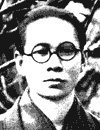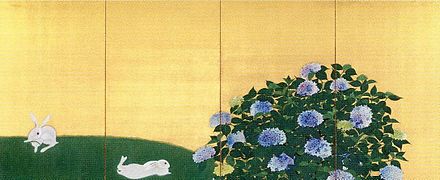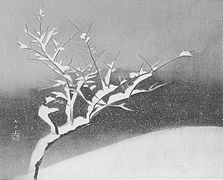Hayami Gyoshu
Hayami Gyoshū ( Japanese 速 水 御 舟 ; born August 2, 1894 in Tokyo ; died March 20, 1935 ) was a Japanese painter of the Nihonga direction.
life and work
Hayami Gyoshū is actually called Makida Eiichi ( 蒔 田 栄 一 ). At the age of 13 he attended the Angadō Gajuku ( 安雅堂 画 塾 ) art school of the painter Matsumoto Fukō ( 松本 楓 湖 ; 1840-1923), where he copied old paintings from the Song , Yuan and Yamato-e periods . With his classmates he founded the “Acorn Club” ( 団 栗 会 , Donguri-kai ) and was eager to roam and draw with them through nature. In 1909 his teacher Fuko gave him the stage name Kako ( 禾 湖 ). From 1910 Gyoshū showed pictures in the Yamatoe and Rimpa style in the Tatsumi gakai, the Ugō-kai, the Bijutsu Kensei-kai and in other places. In 1911 his painting “ Topping- out Ceremony ” ( 室 壽 の 讌 , Murohogi no en ) was bought by the imperial court. In the same year he joined the Kōji-kai ( 紅 児 会 ), to which Imamura Shikō , Yasuda Yukihiko , Kobayashi Kokei and others belonged.
In 1912 he changed his name to Kōnen ( 浩然 ), but in 1914, when he succeeded his mother's family, he called himself Gyoshū. When the Nihon Bijutsu-in ( 日本 美術 院 ) was revived in the same year , he submitted his picture "Papermaking in the neighboring village" ( 近 村 紙 す き 場 , Kinson kamisukiba ) and became a member. When the artists' association around Imamura, the Sekiyō-kai ( 赤 曜 会 ), was founded in 1914 , he also became a member there and enriched it with his integration of the Nanga and Rimpa painting tradition. When Imamura died unexpectedly in 1916, Gyoshū lost one of his best friends.
In 1917, Gyoshū presented at the 4th exhibition of the bijutsu-in "Six Scenes to Kyōto" ( 洛 外 六 第 ), a series of pictures that was highly valued by Yokoyama Taikan , Shimomura Kanzan and other members. The picture shown below is entitled "The village of Shugakuin in northern Kyoto" ( 洛 北 修 学院 村 , Rakuhoku Shugakuin-mura ). Shortly thereafter, at the age of 23, he became an associate member of the bijutsu-in. In 1920 he exhibited the picture " Maiko of Kyōto" ( 京 の 舞 子 , Kyō no maiko ), which caused controversy because of its realistic representation.
Gyoshū nevertheless pursued his personal painting style within the Nihonga. This is how he created pictures “Dance in the Flames” ( 炎 舞 , Embu ) and “Famous Camellia Losing Flowers” ( 名 樹 散 椿 , Meiju chiritsubaki ), which made him famous to this day. Both have been declared an important cultural asset of Japan and are, along with over 100 other works, in the possession of the Yamatane Art Museum . The museum also owns the pair of adjustable screens “ Moss green and meadow green” ( 翠 苔緑 芝 , Suitai ryokushi ) with a total width of 7 m.
In 1930 Gyoshū toured various countries in Europe, traveling to Greece and Egypt, in 1932 he traveled through Korea. In 1934 he fell ill and died, only 41 years old.
photos
Remarks
- ↑ The Nihon bijutsu-in, originally founded by Okakura Kakuzō , was initially given up after his death in 1913.
- ↑ The title is a modification of the title Rakuchū-Rakugai ( 洛 中 ・ 洛 外 ), "In and around Kyōto".
- ^ Gift of the artist to the Museum of Asian Art in Berlin, after the "Exhibition of works of living Japanese arts" in the Prussian Academy of the Arts Berlin, 1931.
literature
- Tazawa, Yutaka: Hayami Gyoshu . In: Biographical Dictionary of Japanese Art. Kodansha International, 1981. ISBN 0-87011-488-3 .
Web links
| personal data | |
|---|---|
| SURNAME | Hayami, Gyoshu |
| ALTERNATIVE NAMES | 速 水 御 舟 (Japanese, stage name); Makida Eiichi (real name); 蒔 田 栄 一 (Japanese, real name) |
| BRIEF DESCRIPTION | Japanese painter |
| DATE OF BIRTH | August 2, 1894 |
| PLACE OF BIRTH | Tokyo |
| DATE OF DEATH | March 20, 1935 |







